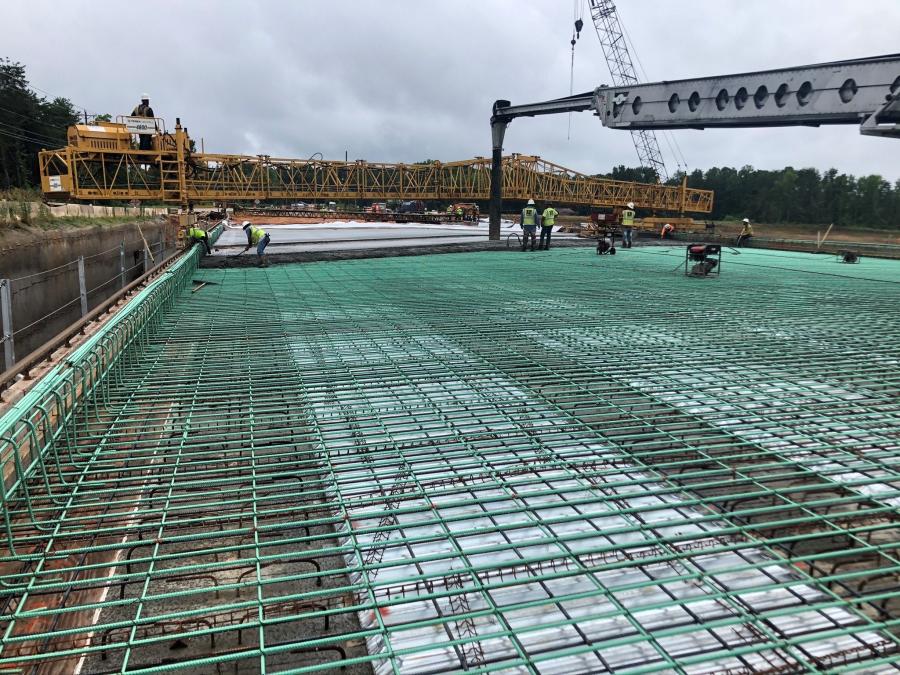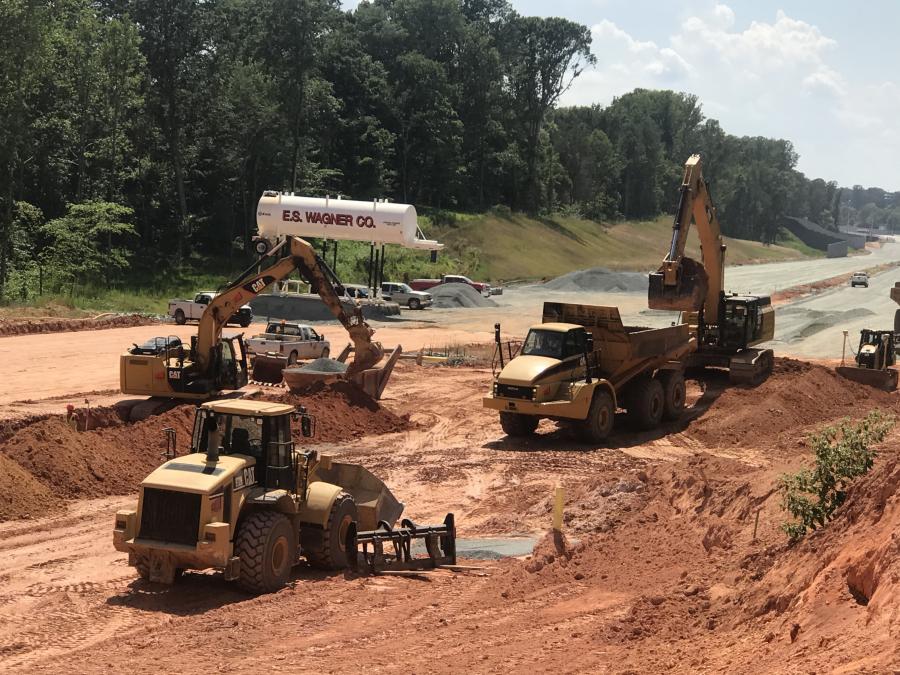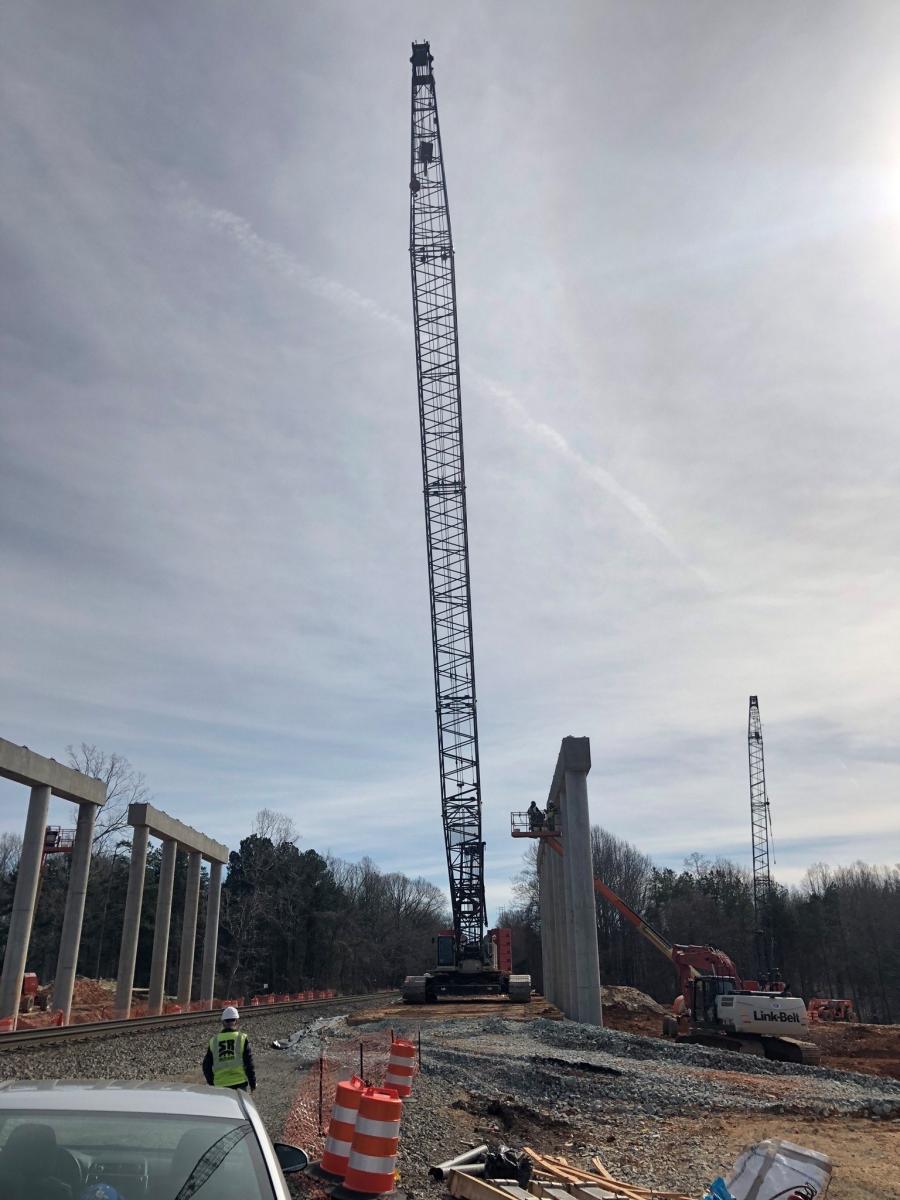The final section — the Northern Loop — of the North Carolina Department of Transportation’s (NCDOT) Greensboro Urban Loop, is being constructed by E.S. Wagner/Smith-Rowe, joint venture.
(E.S. Wagner/Smith Rowe JV photo)
The final section — the Northern Loop — of the North Carolina Department of Transportation's (NCDOT) Greensboro Urban Loop is being constructed by E.S. Wagner/Smith-Rowe, joint venture.
Crews began work on the $121 million section in April 2018 and are expected to deliver the section in late 2022.
"The Greensboro Urban Loop is part of NCDOT's plan to improve traffic flow within and around the city," said Aaron Moody, NCDOT's public relations officer of Division 7. "Construction of the loop will allow traffic to bypass Greensboro and improve congestion on existing I-40, particularly in the area that includes I-40, I-85 Business and U.S. Routes 29, 70, 220 and 421. Four sections, three that are complete, make up the 15 mi. of roadway that will complete the 44-mi.-long loop around the city."
Interstate 840, the designation that will follow the loop north of Greensboro from I-40 on the eastern side to I-40 on the west side, will meet significant transportation needs for the Triad Region. Construction of the loop project, taking place in Guilford County, began in 2013.
The Western Loop 1 ($141 million) covered the area from north of Bryan Boulevard to U.S. 220 (Battleground Avenue) in northwest Greensboro. It included six lanes, finishing an interchange and building a new one. The project was completed by Vecellio & Grogan in March 2018.
The Western Loop 2 ($55 million) covered U.S. 220 and Lawndale Drive in northwest Greensboro. The work included six lanes, finishing the 220 Interchange and a constructing a new one connecting the Greensboro Loop to Lawndale Drive. It was completed by Flatiron on Dec. 30, 2019.
The Eastern Loop ($154 million) is between U.S. 70 and U.S. 29 north of Greensboro. Flatiron built four lanes, finished the U.S. 70 interchange and built two new interchanges connecting the Greensboro Loop to Huffine Mill Road and U.S. 29. It was completed in December 2017.
"The current design is a six-lane highway in each direction from the proposed interchange with U.S. 29 westward to the interchange with Bryan Boulevard near the airport," said Moody. "Since the planning and environmental studies were completed in the mid-1990s, growth has increased in northern Greensboro. When NCDOT updated the traffic model for the project, the number of vehicles predicted to be using this part of the Greensboro Urban Loop increased."
The Northern Loop, 5.3 mi., will be a six-lane freeway from U.S. 29 north of Greensboro to Lawndale Drive in northern Greensboro. The work includes:
- the completion of the U.S. 29 and Lawndale Drive interchanges;
- the construction of two new interchanges that connect the Greensboro Loop to Yanceyville Street and North Elm Street;
- bridges built on the Greensboro Loop over Lees Chapel Road and Norfolk Southern Railroad and on Summit Avenue, North Church Street and Lake Jeanette Road over the Greensboro Loop;
- building a cul-de-sac at the end of Watlington Road; and
- connecting Pindals Road to Candlenut Road to eliminate the intersection of Pindals and Summit Avenue.
NCDOT Roadway Design and Wetherill Engineering designed the Northern Loop.
"One of the biggest challenges with this project is the amount of earth work," said Patty Eason, NCDOT's construction engineer, Highway Division 7. "There is approximately six million cubic yards of dirt to move. Other challenges include the community impact. The expected lifespan of the bridges is approximately 50 years, and 30 years for the concrete pavement. A unique material being used is the kiln-dried lime to dry out the earthen material that had become wet due to extreme rainfall in the initial phases of construction.
"The majority of hauling is done on-site, but when necessary, routes are selected that are normal designated truck routes," she added. "Steel plates are placed to cross other roadways, and mats are placed to remove dirt off of vehicles as they leave the sites. This is a new route, so construction along the mainline can occur as the contractor determines his schedule."
When fully open to traffic, the Greensboro Loop will be able to carry 96,500 cars and trucks daily.
The traffic impacts have been minimal and NCDOT is cooperating with local authorities and the JV to ensure that equipment and material (new and excavated) can easily be brought in and out of the construction zone.
The span from Lawndale Drive to North Elm Street is scheduled for completion in December, and the entire section from Lawndale Drive to U.S. 29 should be delivered in November 2022.
So far E.S. Wagner/Smith-Rowe has completed the following elements:
- the permanent bridges at Lake Jeanette Road and Yanceyville Road;
- excavation of 2.3 million cu. yds. of soil;
- placing 9,000 tons of lime-kiln dust subgrade stabilization and 90,000 tons of aggregate base; and
- the installation of 29,500 lineal ft. of storm structures; 7,500 cu. yds. of reinforced box culverts; 7,800 linear ft. of water main; and 5,500 linear ft. of sewer main.
The rest of the 2020/21 construction season is focusing on completing the concrete paving; opening a section of the Greensboro Urban Loop from Lawndale Drive to Elm Street; and structures on Yanceyville Road, Church Street and Summit Avenue.
E.S. Wagner is managing the JV and performing all of the earthwork and roadway construction, while Smith-Rowe is responsible for the bridges, retaining walls, utility work and clearing and grubbing operations.
"There's about 6.5 million cubic yards of embankment that's generated through a combination of on-site cuts and borrow excavation. The overall challenge is the coordination of the project," said John Wagner, executive vice president of E.S. Wagner. "It's a complicated job to manage and maintain the construction schedule. Since the project's inception, we have had a couple of wet seasons, which continue to impact our earth moving operations. To overcome that, we've had to modify our schedule, utilize some different spreads and locations than what we bid to perform the work. We do our best to be cost-effective despite the bad weather.

"The soil we're removing, because of the weather, is wetter than we anticipated because of all the accumulated moisture we picked up over the last 2.5 years — it was much drier when we did our sampling at bid time," he added. "In order to achieve compaction, you have to achieve an optimum moisture content and the wetter it gets, the more difficult to get compaction."
The schedule also has been impacted by utility relocations that the JV was not responsible for.
"Power and communications were relocated by the DOT and utility owners," said Wagner. "Some of those lagged behind. We worked through that with NCDOT and, in some instances, were able to re-sequence some operations. We have been issued some extensions to the completion date to offset the utility impacts that drove our critical path."
Day shifts are the norm, although structural concrete pours are done at night.
"You phase that work at night when traffic volumes are less," said Wagner. "Concrete is easier to handle at night because it has a tendency to heat up and hydrate and set up too quickly in the warm daytime hours. The key to managing a project like this is scheduling. We have a very elaborate critical path method schedule that we update on a weekly basis and monthly at a minimum. We use it to gauge our progress and where we need to focus our efforts to maintain the path.
"NCDOT is outstanding to work with. We have open lines of communications and we treat them fairly and deliver a quality product," he added, "and in turn they treat us fairly. We disagree from time-to-time, but we've been able to resolve any disagreements amicably. I have worked in a number of states and would rank NCDOT as one of the very best."
The highway is being built through forests, fields and farmland.
"The site was heavily wooded when we started," said Wagner. "The clearing and grubbing operations were critical early on. The bulk of the mainline is cleared at this point. They are clearing the final borrow area now."
The trees are a combination of hard and soft lumber, with the hard wood sent to saw mills and the soft wood being ground. Smith-Rowe is using Timbero tracked and Caterpillar tired feller bunchers; Cat skid steers and Cat knucklebooms to clear the trees.
"The clearing on the project was for the most part routine work, but it was always a challenge working around environmentally sensitive areas," said Locke Rowe, Smith-Rowe's vice president. "Our biggest challenges for the clearing on this project were the quotas imposed last summer by the mills, which made it really challenging to get the clearing material off the project in a timely manner."
As areas are cleared, earth work and site prep crews move in.
"The first thing that we do, before and after clearing, is install erosion control measures because when you remove vegetation, you destabilize the site and when it rains, it creates erosion and sediment," said Wagner. "It's critical to contain it before it escapes the project limits. We have some limited stockpiling of the soil — only when we have to perform excavations at times when we can't immediately create embankments. The vast majority of the volume is going straight to fill as stockpiling is very expensive."
GPS and UTS-equipped machinery, such as dozers (Cat D4s to D10s) and hydraulic excavators (Cat 349s and larger models) are critical for the earth and site work.
"The bulk of the project is being performed without hard staking," said Wagner. "Our crews utilize GPS rovers to establish their locations and to dictate cuts and fills. The storm drains and wet utilities are hard staked, as are the bridges and structures that are being constructed and the concrete pavement. They are loading onto a combination of on-road trucks for some of our hauls and off-road equipment, primarily Cat 740s and 745s with some configured with trailers, and Cat 621 and 631 scrapers."
Road construction, bridge, retaining wall and utility relocation crews also are making serious progress.
The roads are being built on a stone base with a thin layer of asphalt that provides a seal course protecting the base course below it, which is topped by 13 in. of concrete pavement.
"On a good day, McCarthy Improvement Company, our paving subcontractor out of Davenport, Iowa, is paving about 2,000 feet, two lanes wide." said Wagner. "We anticipate finishing the western third of the job and opening it to traffic this fall. The drainage and pipe infrastructures are installed, preferably at the most opportune times."
Crews are working on portions of interchanges — one each at either end of the project that were started on previous projects and two more in the 5-mi. corridor.
Smith-Rowe is building 11 bridges, with two completed and the rest under construction.
"Some of them are mainline bridges and some are Y-line structures, what North Carolina designates as side roads," said Wagner. "We're nearing completion on the second permanent bridge and we have already constructed and removed a temporary bridge that was used to maintain traffic. The plan of attack changes from structure to structure depending on the design and access. The challenge is coordination with roadway crews, because in some cases the bridges construction has to begin before the roadway is built."
A typical Y-line bridge takes around six months to complete depending on the substructure and whether or not it has MSE walls.
"This project is unique in that there isn't any pile beneath several of the end bents that are located on top of the MSE walls — they are sitting on spread footings, which I think is a new design concept for North Carolina," said Rowe. "The railroad bridge presented some schedule challenges due to the large fills at either approach. It was necessary to come in and get the drilled shafts complete [with] interior bents poured, and center spans set before our JV partner could start placing the embankments on either side of the bridge."
E.S. Wagner is assisted by Mike Meyers, project superintendent, and Smith-Rowe is assisted by Rodolfo Monroy, superintendent.
"Mike is responsible for the day-to-day management and coordination of all field operations, and coordination with our JV partner and the subcontractors," said Wagner. "The team dynamic of our management is excellent. You always have some issues that you have to work to resolve, but we try to be a good partner and establish good relationships with the contractors we work with. That has been the case so far. It's been a frustration for a lot of our work force to not be able to work as much as they would like to because of the rain. We have some very good crews, and we've been able to bring on some excellent people in the Greensboro area."
Peak days have 150 JV and subcontractor personnel on-site, with the major contractors being Thompson-Arthur for asphalt paving; McCarthy Improvement Company for 13-in. PCC paving; Mountain Creek Contractors for concrete box culverts; Nickelston Industries for guardrail and fencing; Cruz Brothers for concrete sidewalk and curb; and Colter Electric for electrical and lighting.
Equipment-wise, the JV is using: Cat loaders (930 to 972); Cat excavators (308Es to 390s); compactors (Raygo 320s and Cat 825s); Cat haul trucks (745s to 773s); Cat scrapers (621s to 631s); and Link-Belt cranes.
"The soils in the Carolinas are abrasive, particularly because of the sand content in the dirt, so we go through a lot of wear items, primarily cutting edges, bucket teeth and items that are in direct contact with the ground," said Wagner. "They have to be continuously replaced. We have a maintenance staff on-site that does the bulk of our day-to-day repairs and preventative maintenance. We also partner with Carolina CAT from time-to-time — they provide mechanics on-site. If we have a major breakdown or a rebuild that is necessary, we'll take the piece of equipment to one of their facilities to perform it."
The JV purchases and rents equipment from dealerships such as Carolina CAT in North Carolina, Blanchard Machinery in South Carolina (Cat), Ohio CAT and Linder Industrial Machinery.
"The dealerships are good to work with," said Wagner. "We buy a lot of Cat equipment and because these are dealerships that we work with on a repetitive basis, we have long-standing relationships with them. They know what to expect from us and we know what to expect from them. We take very good care of our equipment and they know that. They typically provide us with exceptional service because they know our standards are high." CEG
Irwin Rapoport
A journalist who started his career at a weekly community newspaper, Irwin Rapoport has written about construction and architecture for more than 15 years, as well as a variety of other subjects, such as recycling, environmental issues, business supply chains, property development, pulp and paper, agriculture, solar power and energy, and education. Getting the story right and illustrating the hard work and professionalism that goes into completing road, bridge, and building projects is important to him. A key element of his construction articles is to provide readers with an opportunity to see how general contractors and departments of transportation complete their projects and address challenges so that lessons learned can be shared with a wider audience.
Rapoport has a BA in History and a Minor in Political Science from Concordia University. His hobbies include hiking, birding, cycling, reading, going to concerts and plays, hanging out with friends and family, and architecture. He is keen to one day write an MA thesis on military and economic planning by the Great Powers prior to the start of the First World War.
Read more from Irwin Rapoport here.
Today's top stories
























